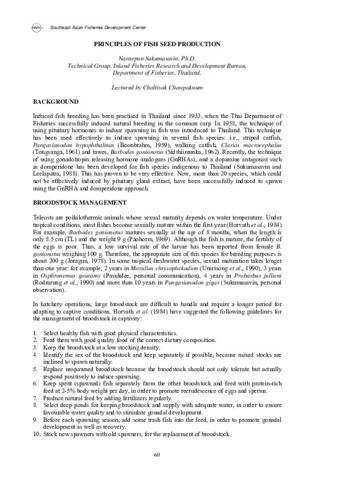Principles of fish seed production
Share
Abstract
Teleosts are poikilothermic animals whose sexual maturity depends on water temperature. Under tropical conditions, most fishes become sexually mature within the first year (Horvath et al., 1984). For example, Barbodes gonionotus matures sexually at the age of 8 months, when the length is only 8.5 cm (TL) and the weight 9 g (Paohorm, 1969). Although the fish is mature, the fertility of the eggs is poor. Thus, a low survival rate of the larvae has been reported from female B. gonionotus weighing 100 g. Therefore, the appropriate size of this species for breeding purposes is about 200 g (Joragun, 1978). In some tropical freshwater species, sexual maturation takes longer than one year: for example, 2 years in Morulius chrysophekadion (Unsrisong et al., 1990), 3 years in Osphronemus gouramy (Pasukdee, personal communication), 4 years in Probarbus jullieni (Rodrarung et al., 1990) and more than 10 years in Pangasianodon gigas (Sukumasavin, personal observation). [Extract]
Suggested Citation
Sukumasavin, N. (2008). Principles of fish seed production. In Handbook on Community-based Aquaculture for Remote Rural Areas of Southeast Asia (pp. 60-75). Bangkok, Thailand: Secretariat, Southeast Asian Fisheries Development Center.
Subject
seed production  ; breeding stock
; breeding stock  ; breeding
; breeding  ; gonads
; gonads  ; animal reproductive organs
; animal reproductive organs  ; oocytes
; oocytes  ; Sex characters; spawning
; Sex characters; spawning  ; induced ovulation
; induced ovulation  ; embryonic development
; embryonic development  ; Zygotes; cells
; Zygotes; cells  ; organogenesis
; organogenesis  ; morphogenesis
; morphogenesis  ; Incubation; hatching
; Incubation; hatching  ; temperature
; temperature  ; dissolved oxygen
; dissolved oxygen  ; Incubators; South East Asia; eggs
; Incubators; South East Asia; eggs 
 ; breeding stock
; breeding stock  ; breeding
; breeding  ; gonads
; gonads  ; animal reproductive organs
; animal reproductive organs  ; oocytes
; oocytes  ; Sex characters; spawning
; Sex characters; spawning  ; induced ovulation
; induced ovulation  ; embryonic development
; embryonic development  ; Zygotes; cells
; Zygotes; cells  ; organogenesis
; organogenesis  ; morphogenesis
; morphogenesis  ; Incubation; hatching
; Incubation; hatching  ; temperature
; temperature  ; dissolved oxygen
; dissolved oxygen  ; Incubators; South East Asia; eggs
; Incubators; South East Asia; eggs 

